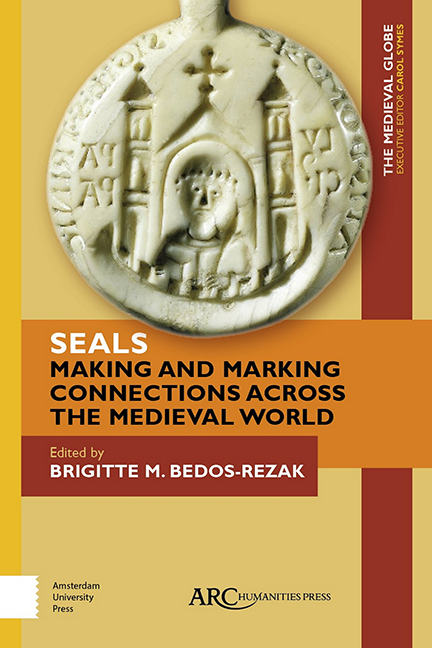Book contents
- Frontmatter
- Contents
- List of Illustrations
- Acknowledgements
- Cultural Transactions: An Introduction to Medieval Seals from a Global Perspective
- Seals as Conceptual and Ritual Tools in Chinese Buddhism, ca. 600– 1000 CE
- Imprinting Powers: The Astrological Seal and Its Doctrinal Meanings in the Latin West
- A Medieval Solution to an Early Modern Problem? The Royal Animal Seals of Jambi
- Expressing New Rule: Seals from Early Islamic Egypt and Syria, 600– 800 CE
- The Formulation of Urban Identity on Byzantine Seals
- The Cloth Seal: A Mark of Quality, Identification, or Taxation?
- Archaeology and Sigillography in Northern Europe
- Medieval Treaties and the Diplomatic Aesthetic
- Index
The Cloth Seal: A Mark of Quality, Identification, or Taxation?
Published online by Cambridge University Press: 20 November 2020
- Frontmatter
- Contents
- List of Illustrations
- Acknowledgements
- Cultural Transactions: An Introduction to Medieval Seals from a Global Perspective
- Seals as Conceptual and Ritual Tools in Chinese Buddhism, ca. 600– 1000 CE
- Imprinting Powers: The Astrological Seal and Its Doctrinal Meanings in the Latin West
- A Medieval Solution to an Early Modern Problem? The Royal Animal Seals of Jambi
- Expressing New Rule: Seals from Early Islamic Egypt and Syria, 600– 800 CE
- The Formulation of Urban Identity on Byzantine Seals
- The Cloth Seal: A Mark of Quality, Identification, or Taxation?
- Archaeology and Sigillography in Northern Europe
- Medieval Treaties and the Diplomatic Aesthetic
- Index
Summary
SIGNS INDICATING POSSESSION have been, and continue to be, stamped, impressed, engraved, or branded on animals, houses, and objects. As manufacture and trade developed in the Middle Ages, marks were applied to objects to indicate their source, quality, and the fact that their purveyors or importers had paid duty or tax. In the city of Winchester, for example, during the fourteenth century every baker sealed the loaves he had baked. Throughout England, in the following century, products were marked by craftsmen such as masons, carpenters, makers of salt blocks, and coopers (who made barrels). Examples of such marks elsewhere in Europe can be found on thimbles, window leads, glassware, clay pipes, ceramic butter pots, imported wire, and kosher food. Metals— such as gold, silver, pewter, and metal ingots— were marked by stamping. Documents were authenticated, before the advent of signatures, by marking with a cross, by the imposition of wax seals, or by tagging with lead or wax seals affixed by parchment strips or cords.
Those wanting to mark textiles sought similar means of identification, and this article will explore how and why the lead seal came to be used for the authentication of cloth. In addition to documents, lead seals have also been used for sealing containers such as wine bottles, for the authentication of relics and sealing of reliquaries, or the sealing of rooms. But, compared with the vast quantity of literature devoted to the wax seals, they have received little attention. This study will show how the lead cloth seal has become an increasingly important area of sigillography and can illuminate the history of manufacture, trade, and taxation from the medieval to modern eras.
Cloth Seals: Nature and Forms
In western Europe, cloth was usually (but not always) sealed by attaching a lead seal to the cloth itself, by bending a blank of lead over the edge of the cloth and stamping a mark or design on one or both sides of the lead. (Occasionally a wax seal was applied directly to the cloth: see below.) The lead seal for textiles first appears in the archaeological record of northern Europe in the thirteenth century, and was in widespread and continuous use until the early twentieth century.
- Type
- Chapter
- Information
- Seals - Making and Marking Connections across the Medieval World , pp. 167 - 192Publisher: Amsterdam University PressPrint publication year: 2019



